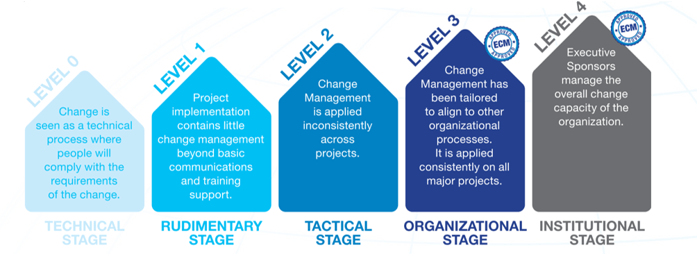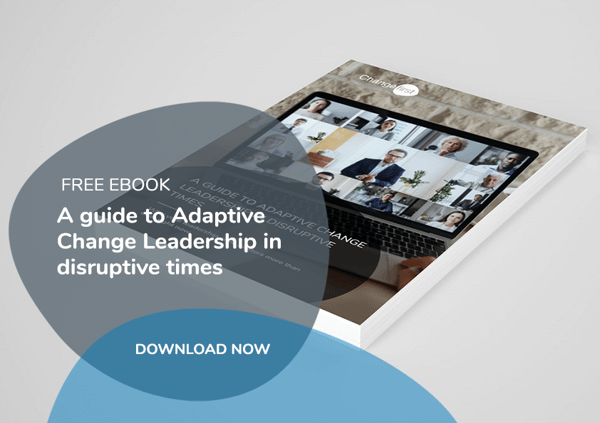At the most mature level of organisational Change Management, the distinguishing characteristic is that executive sponsors manage the overall change capacity of the organisation. Your organisational change management capability may have all the other Enterprise Change Management (ECM) elements in place, but without that C-suite level change leadership, you will still struggle to deliver broad-reaching successful change.

Reaching peak change management maturity requires active executive involvement
Moving from level 3: Organisational to level 4: Institutional, maturity is the biggest step-change of all and represents a substantial cultural shift for most organisations. The key shift is that the capacity for change becomes the key metric when change leaders decide whether to implement a new initiative or not. Even the best change management processes will struggle to get traction if people are overwhelmed by the sheer volume of change.

With a large program of changes, a lack of C-Suite oversight of capacity is high risk
Identifying the volume and pace at which the organisation has the ability to successfully achieve change is a measure often overlooked within organisations. The tendency is to try and drive as many change projects through the organisation as quickly as possible. This leads to organisational change skills, leadership, and time being spread too thinly over projects, resulting in solution delivery - rather than proper benefits realisation.
Here we see a Value gap created between the business case expectations and the actual benefits achieved.

Too little time leads to poor execution. This trickles from the top down through the whole organisation as each leadership layer struggles to cope with the sheer volume of work. We often see this manifest itself at the senior leadership level where executives have little time to track and reinforce initiatives once the strategy is announced; and spending minimal or no time on reviewing, coaching, and leading staff accountable for implementation planning.
Having insufficient time, they delegate the execution of key initiatives to mid-level programme managers and other staff support groups. This in turn means that leadership for the change initiative is diluted or absent. Inevitably the change initiative loses urgency, momentum, and credibility for those touched by the change.
This impact then trickles down to the next level of leadership, already overwhelmed by the amount of work they need to deliver, plus being expected to pick up additional work to fill the gaps left by the executive sponsor. And so they delegate and so on and so on.
Proactively managing the overall change portfolio and assessing the organisational change capacity before initiating projects is a key role of the C-Suite. This check mitigates the risk of driving through more change than the organisation can deliver.
The C-Suite’s role in Enterprise Change Management Capability
At level 4 of change management maturity the key characteristics of the organisational change capability are:
- Change Management is adopted throughout the organisation
- Executives spend time assessing the demand for change as a whole and the level of capacity the organisation possesses
- Change agents build continuous improvements into change management. Case studies are produced to show the effectiveness of change management.
- Change management is built into the culture – it becomes ‘the way we do things around here’.
Each of these characteristics requires C-Suite support to achieve; whether by visibly driving the culture of change management or providing resources, budget and, importantly, their own personal time, for change management activities.
Coupled with this, two key leadership attitudes also need be evident at the C-Suite level and cascade down:
- Managing change effectively is a core competency in this organisation.
- Assessing people’s capacity and limits to changing successfully is a core part of strategic decision-making.
We have focused this week on the importance of the C-Suite in achieving the highest level of Enterprise Change Management (learn more about the maturity levels here). This is not to say that the C-Suite is not important at other levels of maturity; on the contrary, the C-Suite and executive-level has an important role to play at all levels of maturity.
We explore this further next week as we look at the 3 organisational level success factors required for successful change. You can read more about ECM in our book Enterprise Change Management.
|
|
Are you looking to develop your ECM capability? In our high-velocity world of change, Change Management has to be everyone’s business. Not just the 'special sauce' of a small number of experts. How do you make that happen? Visit our website to learn more.  |




Leave a comment